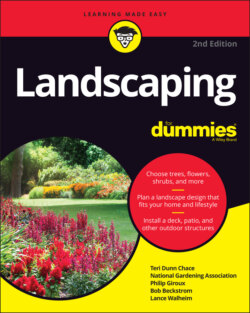Читать книгу Landscaping For Dummies - Lance Walheim - Страница 24
Making sure you know where your property lines are
ОглавлениеOur advice here is quite blunt: Don’t work near or on the bounds unless you know where the bounds are. By that, we mean, don’t plan a change, or don’t start up a new fence, hedge, or any landscaping project close to the edges of your property unless you know for certain where the legal lines are.
You won’t find your property lines drawn on the ground. If you’re lucky, though, you may find monuments, or markers, at one or more property corners. These markers may be conspicuous posts driven into the ground, but more likely, they’re small pipes, rebar, or brass medallions, often buried over time under soil. Property corners at the street are usually marked by small crosses inscribed in the concrete curb or gutter. If you can’t find your markers easily, ask your immediate neighbors or long-time residents living nearby. As a good-neighbor policy, you may want to conduct the search with your immediate neighbors anyway, especially to clarify the ownership of fences.
Keep in mind that your actual property line may be set back several feet/a meter or so from its markers. Also check your deed to see whether the street occupies an easement along the front of your property (an easement essentially means that your city, county, or neighbors may use the space if ever needed).
When you can’t verify your property lines, you need to hire a professional land surveyor (PLS); they can also provide seasoned advice about any disputes or ambiguities.
Tax maps, sorry to report, are estimations and won’t hold up in a legal dispute. Deeds have written descriptions, not so useful to you in this situation. If your deed references a recent survey map, that can be useful … you can trace it.
